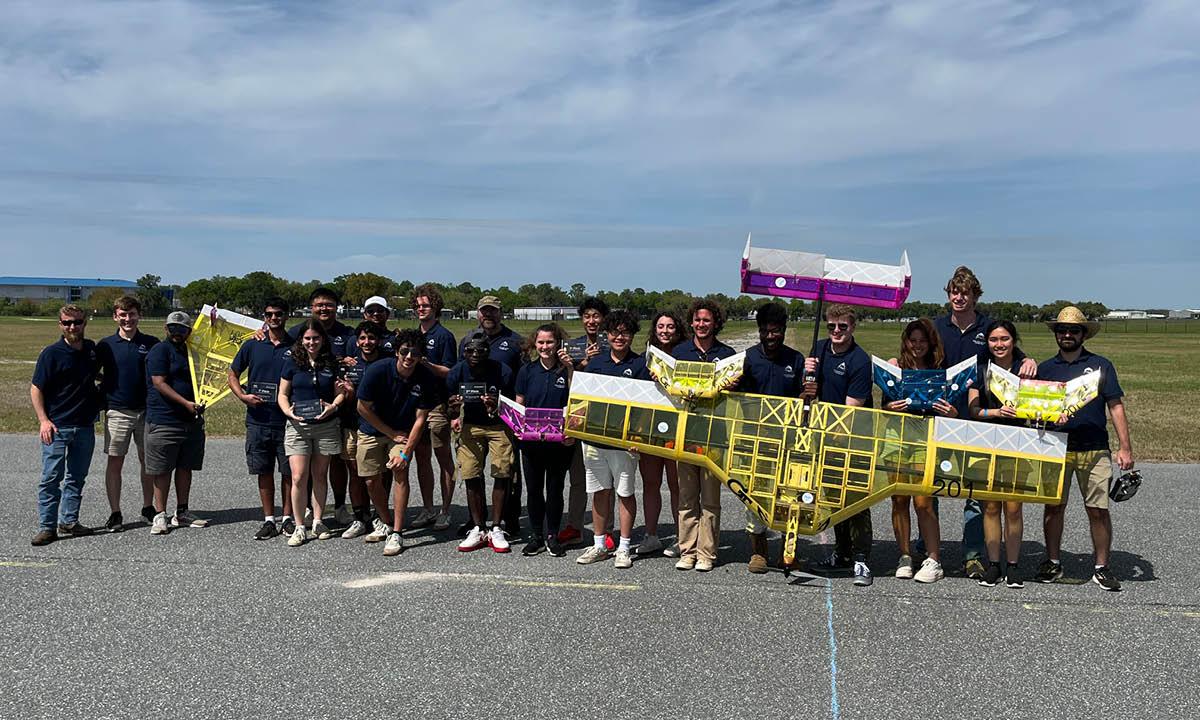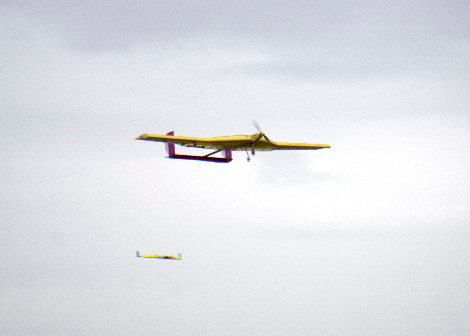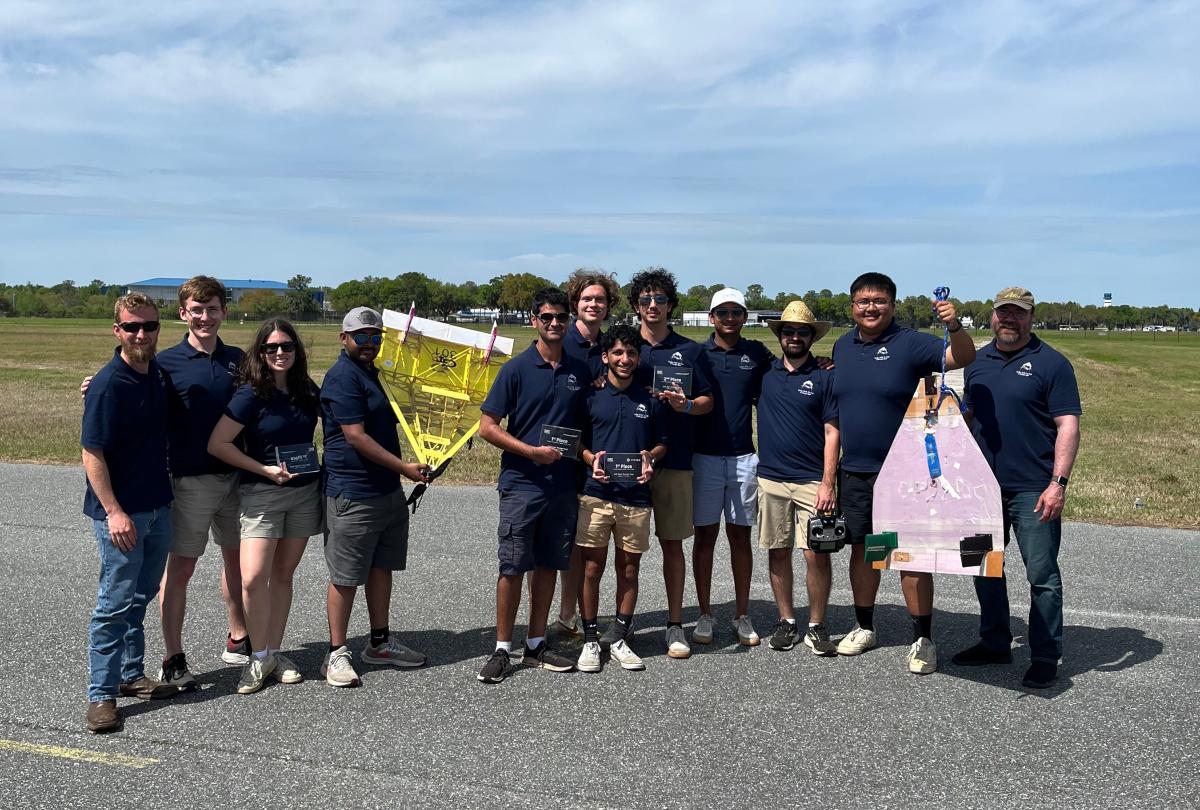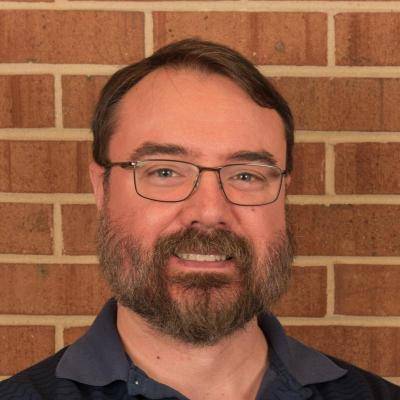The ASDL Design Build Fly team continues its tradition of triumph.

Design Build Fly team from left to right: Conor Thiels, Michael Francesconi, Deep Patel, Salil Sodhi, Cayetana Salinas, Martin Xiao, David Shaji, Vedant Ruia, Ethan Correa, Avery Truax, Ba Musa Khan, Carl Johnson, Kaci Wadsworth, Albert Lee, Cuong Nguyen, Natalia Garcia, Ryan Warner, Tilahta Agbere, Ira Rosner, Malia Trask, Phillip Clendenin, Nicole Nguyen, and Max Kramer.
The Aerospace Systems Design Laboratory (ASDL) Design Build Fly (DBF) team took first place overall in the Micro and Advanced Class at the Society of Automotive Engineers (SAE) Design East Competition in Lakeland, Florida. This year’s competition included more than 55 teams from all over the world, including Brazil, China, India, Poland, and Mexico.
“The team worked incredibly hard this year, and we were the most prepared we've ever been for a competition. When we had little things go wrong during competition everyone pulled together and responded positively. We were also one of a few teams that were specifically called out by the organizers at the awards ceremony for good sportsmanship and helping other teams.”
Carl Johnson, ASDL research engineer, and DBF team advisor.
ExSTINGuisher to the Rescue
This year’s Advanced Class Team, led by Tilahta Agbere and Ryan Warner, placed first overall, first in design, second in presentation, and first in flight performance with their ExSTINGuisher aircraft system.
The team was tasked with designing and building two radio-controlled aircraft and a custom Data Acquisition System (DAS) to perform a firefighting mission. The mission entailed using their primary aircraft ExSTINGuisher, a larger aircraft limited to a 10-foot wingspan and 750 watts of electric power for propulsion, to carry water and a one-pound secondary aircraft. After the primary aircraft takes off, a target acquisition system comprising of a camera and the DAS is used to survey the field for a pre-determined colored target placed randomly by competition officials.
After determining the location of the target, the coordinates are sent to the secondary aircraft, which is then dropped from ExSTINGuisher via a command from the ground station crew. Once dropped, the secondary aircraft must navigate to and land within 15 feet of the target. If the landing is successful, the secondary aircraft is then converted into a Ground Transport Vehicle (GTV) capable of delivering the water carried by the primary aircraft through an obstacle course.
DBF has been dominating Advanced Class, taking first place for nine of the past ten years. The competition rules were highly complex, with multiple deliverables, but that didn’t stop them from beating out the competition.
“We’ve been preparing all year, but Advanced Class has ten years of experience passed down to each team, so we were able to build on the wealth of flight-testing knowledge,” Warner shared.
To successfully create an aircraft system for a mission of this caliber, a meticulous design and build process was undertaken.
“There are times in the lab when something is just slightly off. Instead of choosing to run with it when building an aircraft that would probably fly, we will scrap it and do it again to ensure it’s done right,” Warner, a fourth-year student, said.
Also, multiple systems needed to be designed in parallel to ensure the aircraft system was completed on time. Rather than centralizing the decision-making, responsibilities were delegated to various sub-teams headed by Malia Trask, Phillip Clendenin, and Albert Lee.
“You just have to trust your team,” Agbere said. “It was my first time being chief engineer, so there were many things I wasn’t prepared for, but I learned that just trusting your team makes things a lot easier to get done. You don’t have to know everything.”
They built three aircraft: the prototype and two for competition. After building those aircraft, they flew each one at a flying field in McDonough, Georgia, with the help of their pilot Max Kramer.
From left to right: Carl Johnson, Ba Musa Khan, Cuong Nguyen, Kaci Wadsworth, Natalia García, Ryan Warner, Tilahta Agbere, Ira Rosner, Albert Lee, Malia Trask, Phillip Clendenin, Nicole Nguyen, and Max Kramer.

Powered autonomous delivery aircraft (PADA) dropping from the main aircraft
- Dalton Vega, AE 2022 - Chief Engineer,
- Ishan Padmani, AE 2023 – Chief Engineer,
- Grant Ewing, AE 2023 - Project Manager.
Flight Testing Makes Perfect
This year’s Micro Class brought home first place overall, first in design report, second in presentation, and first in flight performance with their aircraft BUZZquarium. DBF has taken first place in the Micro Class five times in a row and nine out of the last ten years.
The Micro Class team's mission is to design an aircraft that could carry as much water as possible while taking off in a short distance. In addition, the aircraft was limited to 450 Watts of power and had to maintain a small wingspan and be as light as possible
These requirements resulted in the final design of BUZZquarium being a 2 foot wide, 3 feet long delta wing which carried three pounds of water. The center part of the fuselage held the water tank secured by a lid.
The team came up with their first prototype 40 days after the competition ruleset was released. They did a lot of flight testing and had several crashes. Through trial and error, they improved their original aircraft design.
This year’s team was led by three seniors: Salil Sodi, who was the chief engineer, Vedant Ruia, the project manager, and Cayetana Salinas.
“We focused on aircraft optimization for the Micro side of the competition. Our design was performance driven, while Advanced Class is more focused on the integration of several systems,” Ruia explained.
For the competition, an aircraft that can fly the mission well is not enough. The plane had to stay together without any breaks to be considered a success. Then, the team needed to unload the water inside the aircraft in one minute. If the water wasn’t unloaded within that time, then that water wasn’t counted.
“The windy weather was our biggest challenge, especially with such a small aircraft. The wind can really push the plane and affect the landing. If the plane goes off the runway on landing, the flight is disqualified,” Salinas shared.
Sodhi advised future DBF members, “We brought five planes to the competition; you can never be too prepared. We had flight tested all of our planes multiple times, but the weather can throw you a curveball at the competition, so being prepared to handle it is the key.”
Ruia followed up by saying, “If anything can go wrong, it will go wrong. Be prepared for anything.”

From left to right: Conor Thiels, Michael Francesconi, Cayetana Salinas, Deep Patel, Salil Sodhi, Avery Truax, David Shaji, Ethan Correa, Vedu Ruia, Max Kramer, Martin Xiao, and Carl Johnson.
Micro Team from left to right: Michael Francesconi, Vedant Ruia (wearing hat), Ryan Wijaya (standing up), Salil Sodhi, Cayetana, and Salinas, David Shaji.
(text and background only visible when logged in)
